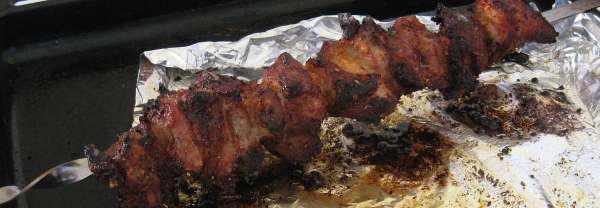|
|
Shashlyk in Ukraine

The Shashlyk Tradition
Shashlyk is the essential component of any picnic in Ukraine. Americans love to get out their grills for hot dogs and hamburgers on hot summer holidays. Similarly, in Ukraine, it just wouldn't be a complete May Day or Maslenitza holiday without Shashlyk grilled outside. The favored places for grilling your own shashlyk are: beside lakes or rivers; in the woods; or even just along a grassy or woody stretch alongside a highway. Of course, there are also many "shashlychnayas" (shashlyk cafes) where you can order shashlyk grilled to order. At any park in the summer months, you'll see the many white smoky trails going up from shashlyk grills everywhere.At its simplest, shashlyk is just meat (usually marinaded, always seasoned) cooked on skewers or spits over a smoky, smouldering (not flaming) grill.
But each family has its own individual way of making shashlyk, and their own traditions (remember fondly from childhood) to go with it. Here you can read several authentic shashlyk recipes. From the favorite shashlyk of a famous Georgian singer, to the Georgian Ambassador to Ukraine, to the very great-grandson of Stalin himself. The information was compiled from interviews appearing in Cegodnya, a Ukrainian newspaper.
How to Make Shashlyk
Shashlyk Recipe from an Ambassador
Here is the simple, but delicious, formula used by Grigol Shalvovivh, the Georgian Ambassador to Ukraine. Believingthat the best shashlyk comes from pork, he always starts with about 5 pounds of pork meat. He prefers the "entrecote" or pork butt. For a morning outing, he will cut the meat in good-sized chunks the evening before, and arrange a bottom layer of this meat ina large bowl or other container. He then salts and peppers the meat, and adds a layer of onion, sliced into thin rings. Onto this go additonal layers of meat followed by onions. He insists that ne never uses a marinade. He lets this meat and onion combination sit overnight. The next day, when the grill is hot, he throws away the onions, just grilling the meat on skewers over the coals. He does not add any liquid while grilling, either. This results in a somewhat dry shashlyk. The cooked shashlyk is then garnished with rings of freshly cut onion, and served with a traditional Georgian plum sauce. Naturally, he accompanies his shashlyk with Georgian wine.A Famous Singer's Shashlyk Recipe
Famous Georgian singer Soso Pavliashvili favors this shashlyk recipe. The meat (he uses either beef or mutton) should be absolutely fresh. Cut it into medium sized pieces and mix with onion, salt and black pepper. Onto this, he pours "Adzhika" (a garlicy, hot pepper sauce). But never adzhika bought in a store, he insists, only the homemade kind sold in the bazaars. Add some freshly squeezed lemon juice to this (the more the better!) Then let it all sit for half an hour. The "secret" of this recipe is to use dried grape vines for the grill. That gives a unique, piquant flavor to the shashlyk.

How Stalin's Great-Grandson Makes Shashlyk
The great-grandson of Josef Stalin, the famous Soviet leader during World War II, tells his secrets of making shashlyk. Here is how the day of a shashlyk picnic goes for Jacob Dzhugashvili. He wakes up at 4am, so that by 4:30 he on his way to the central market in downtown Tbilisi (the capital of his Georgia, where he lives). He goes to the wholesale meat area, where meat arrives from all of the regions of Georgia. He always gets the meat that comes from the Kakhetin region. He buys a 100-pound or so pig carcus, and has butchered right at the market. He then takes the meat to his parents-in-law house -- they have the stone grill where the shashlyk will be prepared.There, the picnic area has already been prepared and his wife has started the charcoal fire. There's no need to rush into cutting up the meat. First, they enjoy a little glass of "black wine" (as red wine is called there), with some cheese and bread to nibble on.
The meat should be cut into pieces so that each piece has some fat on it. Fat keeps the meat moist and gives it flavour. Each piece of meat is also salted individually. To test the seasoning, he licks a piece of meat. If it's over salted, he washes it in cold water and salts it again. They put all of the seasoned pieces of meat into a big pot, cover it and forget about it until the guests arrive.
Then, the meat is speared onto skewers -- 6 pieces of meat per skewer, placed right against each other. After all the flames have completely died down, place the skewers of shashlyk over the coals. He thoroughly wets an old newspaper and spreads it over the shashlyk for a few minutes. Leave it until the newspaper has completely dried and starts to smoulder. Then remove the newspaper.It is essential to have some water (or wine, but not vodka!) handy to put out any flameups from the fat dripping onto the coals.
Here's how you check if the shashlyk is done. Cut into a piece-- if the meat is white, it is done and ready to go to the table.
The tradition in Georgia is to remove the pieces of meat from the hot skewer with a piece of bread. The cooked shashlyk is put into a pot with freshly cut rings of onions. Then throw the piece of bread in there, too. Tightly ocver the pot and shake it vigourously so that everything mixes together well with the juices from the fresh-cooked meat. After doing this, you'll find that the piece of bread has become incredibly delicious.